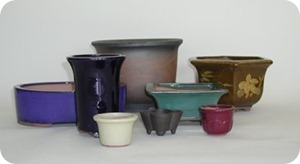 When it comes to bonsai, it is not just the plant and its styling that makes the bonsai appealing to the viewer.
When it comes to bonsai, it is not just the plant and its styling that makes the bonsai appealing to the viewer. The choice of the container that the bonsai is in is also quite important to the overall look and 'feel' of the tree. The container is as important as the tree in a bonsai design.
Usually, growers select the pot after styling the tree, so that the two harmonise in shape, size, colour and texture. Practical and aesthetic factors affect the choice of pot. The purpose of the container is of course to provide suitable accommodation for the tree's needs, but also to compliment its branch structure and seasonal or year-round colours.
The pot must hold enough soil for the roots to develop over a year or two. It should be frost-proof with enough drainage holes. Bonsai containers are usually shallow, but sometimes you may use a deeper one to hold a fruiting tree for example, that needs plenty of water to swell its fruits. (Never try to save on watering time by using a pot too large for the tree, as the roots may become waterlogged and rot.
Evergreens such as conifers, look best in neutral brown pots, but glazed containers should be used for flowering trees or trees with unusual colours or characteristics.
Pots of the colour featured above work well with plants such as Cotoneasters - with their bright red berries. Over the years, it has become traditional to select rather neutral shades of brown, grey and red for evergreens and the more colourful pots of green, blue and white for deciduous trees. It has also long been recognised, for example, that flowering trees look good in green, blue and deep purple pots. The exception to this is that trees and shrubs with red flowers look best in white pots.
Fruiting trees can handle the competition of coloured pots and certain traditions have developed around them. For instance, it is considered the norm for trees with red fruit in white pots, and trees with yellow or orange fruits in blue pots. Basic brown pots are always correct.
Generally, the more mature and aged the bonsai, the plainer the container should be. The more delicate the tree, the lighter in colour the container should be.
Feel free to chose whatever container that you think looks best for your individual bonsai, but as a general rule, oval containers compliment deciduous trees and rectangular ones suit evergreens best (particularly conifers). Hexagonal pots are softer in effect than other shapes - perfect for trees with arching or short and prominent trunks.
The colour, weight and size of a pot should also be given great consideration, as well as whether it should have decoration or not. Larger pots are usually subdued in colour and texture, so that they do not dominate the tree. A smaller pot can be brighter. A container that is too overpowering, is too big, or is not the right colour, takes an enormous amount of the simple beauty of a bonsai away, and detracts from its overall aesthetic appearance.
As a guideline, a mainly vertical tree needs a pot with a length between two-thirds to three quarters of the tree's height. The pot's length should be two-thirds and three-quarters of the overall width of a strongly horizontal tree. As a reservoir for soil and water, a smaller pot needs more depth in proportion to its width than a larger pot does.
Certain styles and types of tree demand deeper pots.
The roots could rot very easily. Most good quality bonsai pots are very expensive, but it is better to pay more for a container that you know is good quality, than to buy a cheap pot that could turn out to be detrimental to your bonsai's health.
Some people might even want to use a slab of rock or slate instead of a traditional container to make a design look especially natural as an alternative to a pot for a forest planting or a bonsai that is spacious and dominating in design. These are usually granite, slate or volcanic rock, but can also be made from painted fibreglass and other materials quite cheaply.
Remember, if you cannot make up your mind on what pot would suit the plant, experiment, and don't be afraid to try something original. You can always repot the bonsai the following year into a more preferred style. Bonsai is a constantly changing process and one that requires a great amount of patience, but is never permanent.

Custom Search
If you liked this article, subscribe to the feed by clicking the image below to keep informed about new contents of the blog:

0 commenti :
Post a Comment